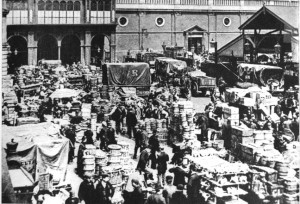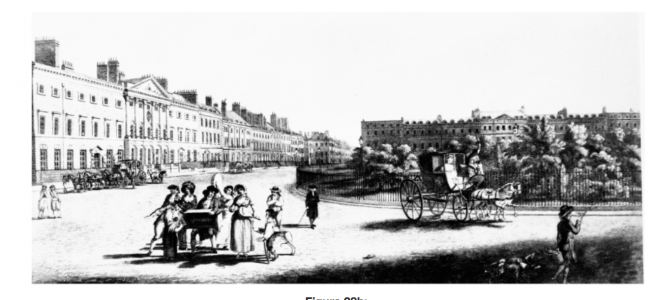Covent Garden is a district in London on the eastern fringes of the West End. The district is divided by Long Acre. The south part contains the central square with most of the elegant buildings, theaters and entertainment facilities.
 Covent Garden Market designed by Charles Fowler, was thought to be the central market of London. It was also thought to be the first of its size and kind. “The building consists of three distinct ranges, united at the eastern extremity by a colonnade that supports a spacious terrace, or balustraded gallery, upon which have been erected two conservatories; these are furnished with the most rare and choice productions, native and exotic, of the flower garden, and are further enlivened by a fountain, that, by a mechanical contrivance, is regulated according to the wind. This is the grand front; and faces Great Russell Street. The central range, a large and lofty avenue, is occupied by the dealers in the more expensive fruits and vegetables, and in their several seasons exhibit a grand display of hothouse and other produce of surpassing beauty and most exquisite flavour.” “Victorian London – Markets – Covent Garden. Victorian London – Markets – Covent Garden. Web. 15 Nov. 2015.
Covent Garden Market designed by Charles Fowler, was thought to be the central market of London. It was also thought to be the first of its size and kind. “The building consists of three distinct ranges, united at the eastern extremity by a colonnade that supports a spacious terrace, or balustraded gallery, upon which have been erected two conservatories; these are furnished with the most rare and choice productions, native and exotic, of the flower garden, and are further enlivened by a fountain, that, by a mechanical contrivance, is regulated according to the wind. This is the grand front; and faces Great Russell Street. The central range, a large and lofty avenue, is occupied by the dealers in the more expensive fruits and vegetables, and in their several seasons exhibit a grand display of hothouse and other produce of surpassing beauty and most exquisite flavour.” “Victorian London – Markets – Covent Garden. Victorian London – Markets – Covent Garden. Web. 15 Nov. 2015.
The northern side consists of shops with small dwellings. The southern side follows suit with the northern. It’s made up of vendors and small dwellings.
 Crimes committed in the area are mostly theft and larceny. However, there are a few murders documented. At first the market was solely a high class area, but as taverns became to spring up in the area the clientele base dropped. Later on the area became a popular red light district where prostitution was a popular vice. There are reports of such behavior but little details on punishments or crime reports.
Crimes committed in the area are mostly theft and larceny. However, there are a few murders documented. At first the market was solely a high class area, but as taverns became to spring up in the area the clientele base dropped. Later on the area became a popular red light district where prostitution was a popular vice. There are reports of such behavior but little details on punishments or crime reports.
Mostly middle class and well to do in the area, some poor.
 After leaving Sibyl in tears in chapter 7 Dorian leaves her not paying attention to where he was going. He ends up in Covent Garden.
After leaving Sibyl in tears in chapter 7 Dorian leaves her not paying attention to where he was going. He ends up in Covent Garden.
“As the dawn was just breaking, he found himself close to Covent Garden.”
This shows he cares about Sybil, but is it Sybil or the loss of his love story he is missing? Most people realize the vain attitude in Dorian and understand that is the loss of his perfect love story and the dramatic change in Sybil’s acting that Dorian is confused and saddened by. Dorian finds himself confused and dazed by Sybil’s dramatic change while Sybil is confused by Dorian’s reaction. Both parties involved have now dealt with the blurring of the line between art and reality.
Covent Garden was the central market of London, and home to its opera house. For Dorian it’s the place that his vain and story like life meet reality. When offered cherries by a kind market boy Dorian was confused. “He thanked him, wondered why he refused to accept any money for them, and began to eat them listlessly. They had been plucked at midnight, and the coldness of the moon had entered into them.” This further tells of Dorian’s personality as kindness is foreign to him.
 Covent Garden is surrounded by theaters including Covent Garden Theater Royal opera house and is in close proximity to Lincoln Inn Fields which is located by the Royal Theater on High Holborn.
Covent Garden is surrounded by theaters including Covent Garden Theater Royal opera house and is in close proximity to Lincoln Inn Fields which is located by the Royal Theater on High Holborn.
Works Cited
“Booth Poverty Map (Charles Booth Online Archive).” Booth Poverty Map (Charles Booth Online Archive). Web. 15 Nov. 2015.
“Covent Garden : Part 1 of 3.” Covent Garden : Part 1 of 3. Web. 15 Nov. 2015.
“The Picture of Dorian Gray (1891)/Chapter 7.” – Wikisource, the Free Online Library. Web. 15 Nov. 2015.
“The Proceedings of the Old Bailey.” Results. Web. 15 Nov. 2015.
“Victorian London – Markets – Covent Garden.” Victorian London – Markets – Covent Garden. Web. 15 Nov. 2015.






